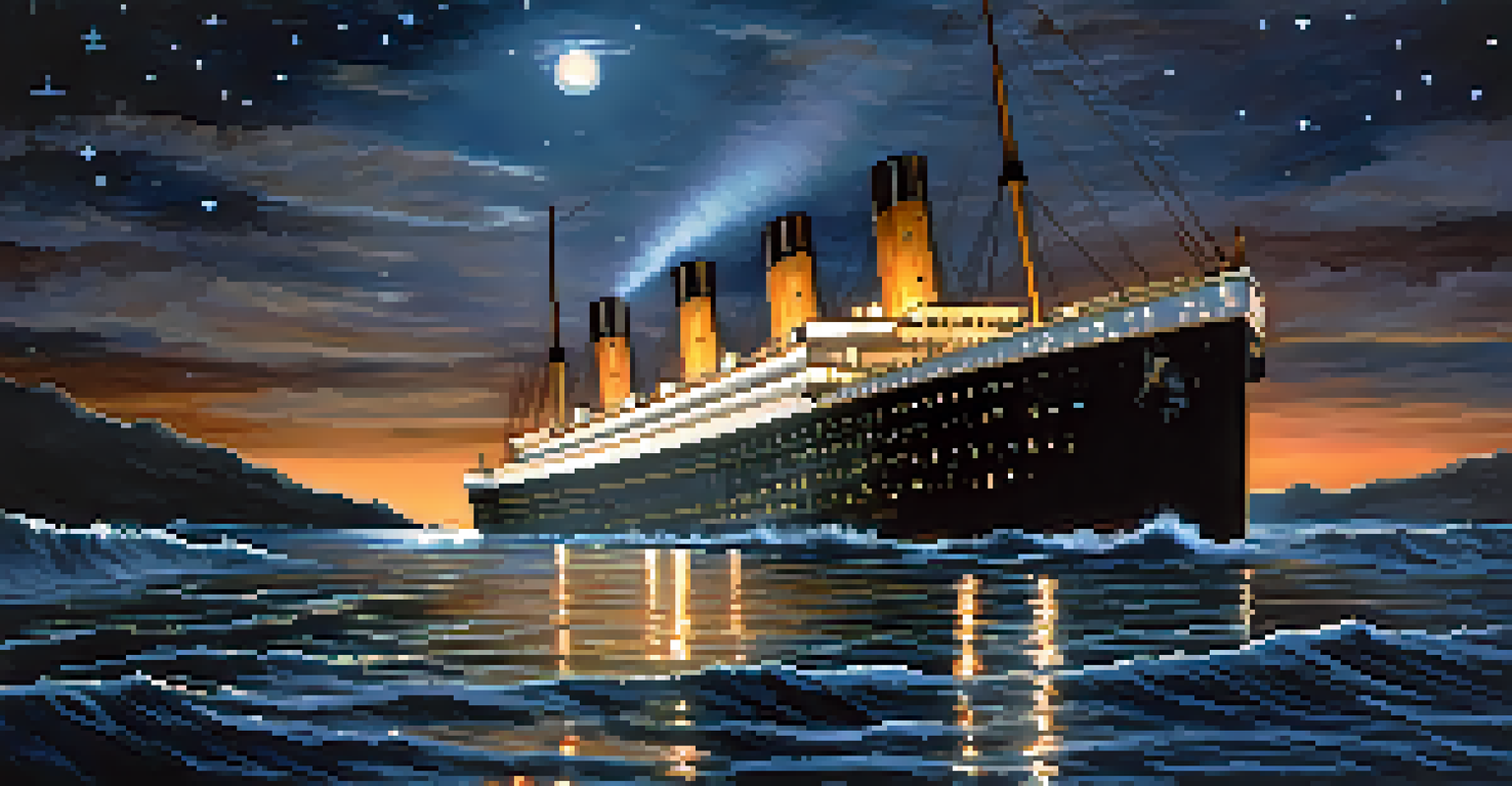The Historical Context of 'Titanic': Fact vs. Fiction

The Titanic Disaster: A Real Tragedy
On April 15, 1912, the RMS Titanic sank after hitting an iceberg, resulting in the loss of over 1,500 lives. This maritime disaster shocked the world and raised questions about safety regulations in shipbuilding. The Titanic was deemed 'unsinkable' due to its advanced safety features, which ironically became a tragic irony. Understanding this event is crucial as it sets the stage for the narrative in both history and the film.
The Titanic disaster is a poignant reminder of the limits of human engineering and the unpredictable power of nature.
The public's fascination with the Titanic story can be traced back to its sheer scale—both in terms of human loss and the ship's grandeur. Survivors’ accounts varied, adding layers of intrigue and speculation to the tragedy. Over time, this event became a symbol of human hubris, prompting discussions about technological advancements versus nature's unpredictability.
The portrayal of the Titanic disaster in films has often emphasized romance and heroism, sometimes overshadowing the real human suffering. While these narratives can be engaging, they often simplify the complexities of the event. As we delve into the mythos surrounding Titanic, it's vital to remember the real stories of those who lived through that fateful night.
James Cameron's Titanic: A Cinematic Phenomenon
Released in 1997, James Cameron's 'Titanic' became a cultural touchstone, blending romance and historical tragedy. Featuring the fictional characters Jack and Rose, the film captivated audiences, earning multiple Academy Awards and breaking box office records. However, the film's focus on love and loss often eclipses the factual events of the sinking, leading to some historical inaccuracies.

While the film showcases the grandeur of the Titanic, many details were either dramatized or altered for cinematic effect. For instance, the depiction of lifeboat usage and passenger behavior during the evacuation diverged from historical accounts. This artistic license raises questions about how history can be interpreted and presented through film, often prioritizing narrative over accuracy.
Titanic's Tragedy and Legacy
The Titanic disaster not only resulted in over 1,500 lives lost but also spurred significant changes in maritime safety regulations.
Cameron’s film has sparked a renewed interest in Titanic's history, prompting viewers to explore the real events behind the story. While it introduces audiences to the tragedy, it also challenges them to discern fact from fiction. This interplay between history and cinema highlights how storytelling can shape our understanding of past events.
The Real People Behind the Characters
The characters in 'Titanic,' while fictional, were inspired by real individuals who boarded the ship. For example, characters like Isidor and Ida Straus mirror the true love story of the owners of Macy's, who tragically perished together. Their poignant narrative reflects the actual lives lost, adding depth to the film while offering a glimpse into the human experience aboard the Titanic.
History is a great teacher, but it is a harsh one. We must learn from our mistakes to prevent future tragedies.
Other real passengers, such as Margaret Brown—later known as the 'Unsinkable Molly Brown'—were portrayed with varying degrees of accuracy. While she did survive, the film's dramatic embellishments often overshadow her true contributions during the disaster. The representation of such individuals brings a layer of authenticity to the cinematic experience, even if some details are glossed over.
Understanding the real stories behind these characters not only enriches our viewing experience but also highlights the myriad of lives impacted by the Titanic tragedy. It invites viewers to appreciate the film's narrative while recognizing the broader context of the actual events. This blend of fact and fiction ultimately deepens our connection to the story.
The Ship's Design and Safety Features
The Titanic was lauded for its luxurious design and advanced safety features, such as watertight compartments and an electronically operated watertight door. However, despite these innovations, the ship lacked enough lifeboats for all passengers—a tragic oversight that contributed to the high death toll. This juxtaposition of opulence and safety shortcomings is crucial in understanding the disaster's complexity.
The film illustrates the ship's grandeur, showcasing its lavish interiors, but often glosses over these critical design flaws. In reality, the Titanic's design was a product of its time, prioritizing aesthetics over safety, which ultimately led to its demise. This tension between beauty and functionality serves as a poignant reminder of the limits of human engineering.
Cinematic Interpretation of History
James Cameron's film 'Titanic' blends romance and tragedy, shaping public perception while often overshadowing factual historical events.
As we reflect on the Titanic's design, it becomes evident that the ship was a symbol of early 20th-century optimism, which was tragically met with disaster. The film captures this essence but sometimes sacrifices accuracy for dramatic effect. Exploring the real engineering challenges faced by the Titanic helps us appreciate the lessons learned from this historical event.
The Role of Media in Shaping Titanic's Legacy
The Titanic disaster was one of the first major news events covered extensively by the press, shaping public perception of the tragedy. Newspapers and magazines published harrowing accounts, often sensationalized, which contributed to the mythos surrounding the ship. This media frenzy not only informed the public but also established a narrative that would evolve over the decades.
As subsequent films and documentaries emerged, they drew from these sensationalized accounts, blending fact and fiction in various ways. The portrayal of Titanic in media has varied from focusing on the tragedy's drama to romanticizing the love story central to the film. This evolution reflects the shifting interests of society and the enduring fascination with the Titanic.
Today, the Titanic's legacy continues to be shaped by both historical research and popular culture, with each new adaptation adding layers to the narrative. The interplay between fact and fiction in media ensures that the Titanic story remains a topic of discussion, inviting future generations to engage with its history. This ongoing dialogue is essential for keeping the memory of the Titanic alive.
The Cultural Impact of Titanic on Society
The Titanic has left an indelible mark on popular culture, inspiring countless books, films, and even musicals. The story has transcended its historical roots, becoming synonymous with themes of love, loss, and tragedy. This cultural impact illustrates how a single event can reverberate through time, influencing art and storytelling.
Cameron's film, in particular, reignited public interest in the Titanic, leading to a resurgence of documentaries, exhibitions, and academic research. Its portrayal of romance against a backdrop of tragedy captivated audiences and sparked discussions about class disparity and human resilience. This blend of entertainment and education has continued to shape how we understand the Titanic narrative.
Cultural Impact of Titanic's Story
The Titanic's narrative has transcended its historical context, inspiring a wealth of cultural expressions and ongoing discussions about human ambition and resilience.
As we reflect on the Titanic's cultural significance, it's clear that it serves as both a cautionary tale and an enduring symbol of human ambition. The story's ability to resonate with audiences across generations showcases the power of storytelling in connecting us to our past. This cultural legacy ensures that the Titanic will remain a poignant part of our collective memory.
Lessons Learned from the Titanic Tragedy
The Titanic disaster prompted significant changes in maritime safety regulations, including lifeboat requirements and improved emergency protocols. These lessons were born from a tragedy that revealed the need for better safety practices in shipbuilding. The event serves as a critical reminder of the importance of prioritizing safety over luxury in any industry.
In the years following the sinking, the maritime industry adopted new technologies and safety measures, ensuring that such a disaster would never happen again. This proactive approach has saved countless lives and transformed the way ships are designed and operated. The legacy of the Titanic is not just one of loss, but also of progress and learning.

As we reflect on the Titanic's impact, it becomes clear that the tragedy serves as a poignant reminder of human vulnerability in the face of nature's power. The lessons learned from this event continue to shape safety standards today, ensuring that the stories of those who perished are not forgotten. This ongoing commitment to safety honors the memory of the Titanic and its passengers.